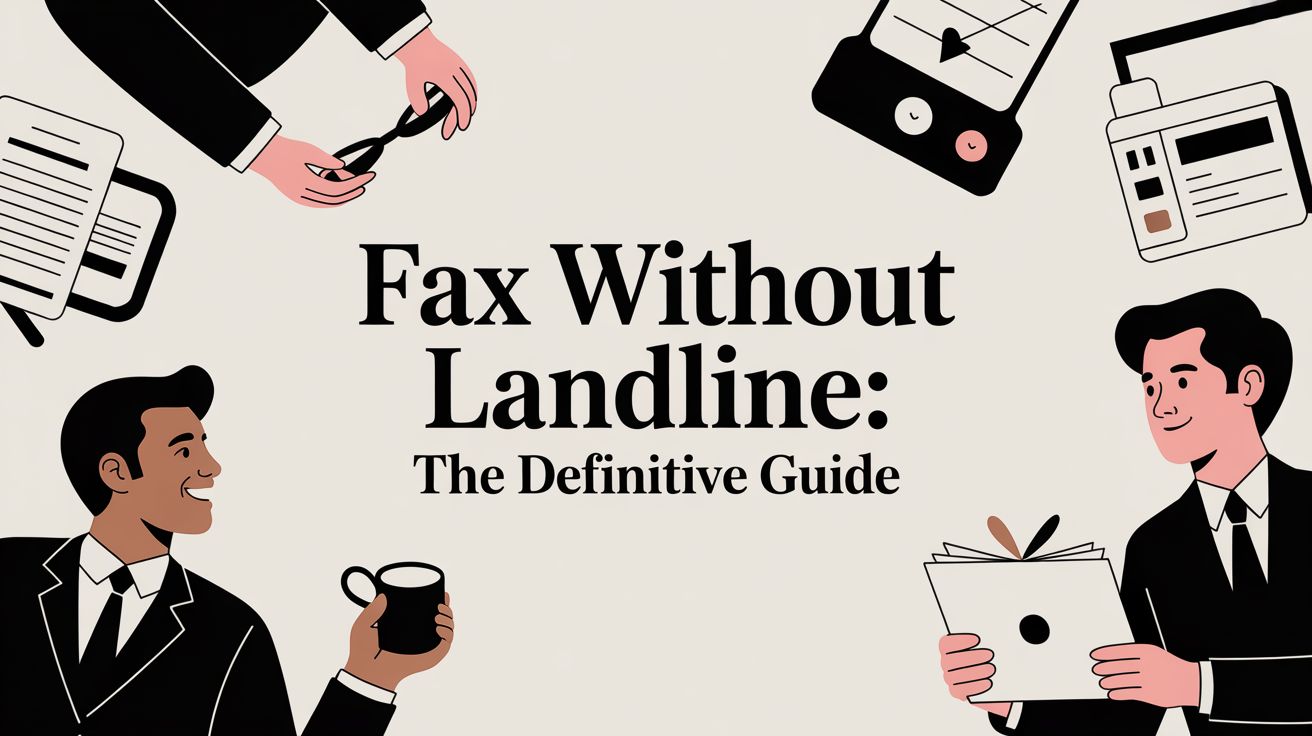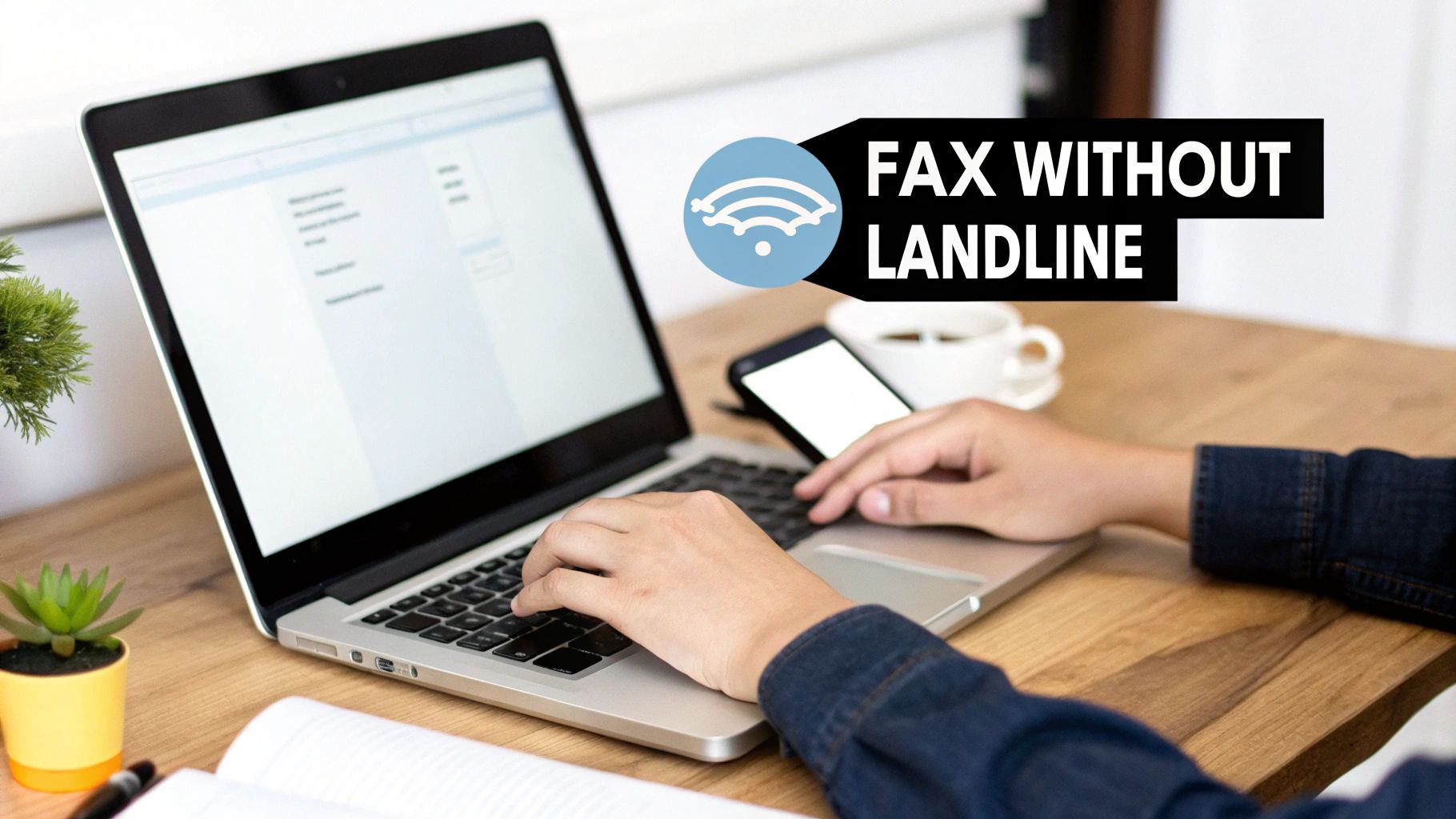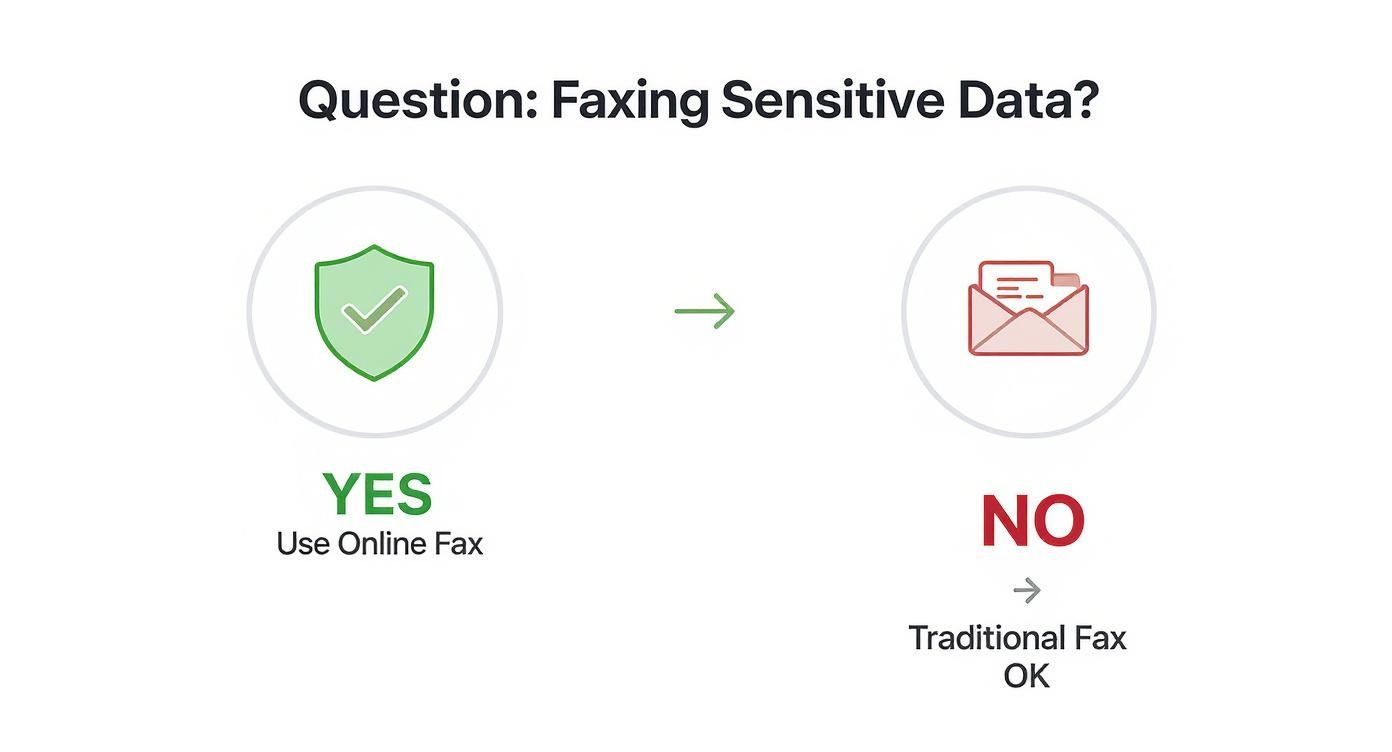Yes, you can absolutely fax without a fax machine. These days, sending a fax is as simple as sending an email, thanks to a whole ecosystem of online services, email-to-fax gateways, and mobile apps. You can handle everything right from your computer or smartphone, no bulky hardware required.
Why Faxing Without a Machine Is Now Standard Practice
Let's be honest, the days of wrestling with paper jams, fighting with toner cartridges, and paying for a dedicated phone line are long gone. While fax technology itself might feel a bit old-school, the need for secure, legally sound document transmission is as critical as ever in many industries. Faxing hasn’t disappeared—it’s just evolved. It’s moved from a clunky piece of hardware in the corner to a flexible tool in the cloud.
This shift isn't just a minor upgrade; it's a complete change in how we manage important documents.

Moving away from a physical machine unlocks some serious, practical advantages that fit perfectly with how we work today, especially for remote teams or small businesses. The benefits are pretty hard to argue with:
- Ultimate Convenience: Need to send a contract from a coffee shop or review a legal document while traveling? No problem. You can send and receive faxes from literally anywhere you have an internet connection.
- Seriously Better Security: Digital faxes are often far more secure than paper ones. Think about it: a traditional fax sits out in the open on a machine for anyone to see. Top online services use strong encryption, sending your documents directly and privately to the intended recipient's inbox or a secure portal.
- Major Cost Savings: Ditching the machine means you stop paying for paper, ink, toner, maintenance, and that extra phone line. Most online fax services offer flexible plans, including pay-as-you-go options that are perfect if you only fax once in a blue moon.
- Effortless Organization: Faxes arrive as neat PDF files in your email or an online dashboard. This makes them incredibly easy to save, search for later, and integrate into your existing digital filing system. No more overflowing filing cabinets.
The Driving Force Behind Digital Fax Adoption
The move to online faxing isn't just a niche trend; it's a global phenomenon. The market for these services hit USD 4.70 billion in 2022 and is on track to reach an incredible USD 12.32 billion by 2030. What's fueling this growth? Industries like healthcare, law, and finance, where faxing is still a non-negotiable part of compliance for handling sensitive information.
According to an in-depth online fax market analysis, North America is leading the charge, showing a clear demand for more efficient ways to handle official documents.
The core reason for this shift is simple: digital faxing retains the legal and procedural weight of a traditional fax while adding the security and flexibility modern work demands. It’s the best of both worlds.
Modern Faxing vs Traditional Faxing At a Glance
If you're still on the fence, this quick comparison makes the advantages of going digital crystal clear. The differences in day-to-day use are night and day.
| Feature | Modern Faxing (Online/App) | Traditional Fax Machine |
|---|---|---|
| Accessibility | Send/receive from anywhere | Requires physical machine access |
| Hardware | None required | Dedicated machine and phone line |
| Cost | Low subscription or pay-per-use | High (machine, toner, paper, line) |
| Security | Encrypted and private delivery | Documents sit in a public tray |
| Organization | Digital, searchable PDF archives | Bulky paper files |
| Speed | Instantaneous digital sending | Prone to busy signals and slow scans |
When you see it laid out like this, it’s easy to understand why so many businesses and individuals have already made the switch. Modern faxing just makes more sense.
Digital Faxing Methods That Actually Work
Alright, now that we've covered why ditching that old machine is a smart move, let's get down to the "how." Sending a fax without a physical fax machine isn't some complex technical puzzle; it's surprisingly simple once you know the modern-day options. The three go-to methods I see people use most successfully are online fax services, email-to-fax, and mobile faxing apps.
Each one has a slightly different feel and is better suited for certain situations. Let’s walk through them with some real-world examples so you can feel confident sending your next document.
Using Online Fax Services
Think of an online fax service as your personal, digital fax concierge. Instead of wrestling with paper jams and busy signals, you just visit a website, upload your file, pop in the recipient's fax number, and click send. It's the most popular way to fax without a fax machine, and for good reason—it’s intuitive and there's zero technical setup on your end.
Let's imagine you need to send a signed rental agreement to a property management company that still relies on fax.
- Head to the Website: You'd start by pulling up a web-based faxing platform. Services like SendItFax, for instance, let you send a fax right from your browser without signing up for an account, which is a lifesaver for one-off needs.
- Upload Your Document: Look for a clear button like "Upload File" or "Select Document." You'd click that and choose the signed rental agreement you've already scanned and saved as a PDF.
- Fill in the Blanks: Next, you'll type in your details and the property manager's fax number. Most services give you a spot for a cover sheet message. This is where you'd add a quick note like, "Signed rental agreement for Unit 4B, as requested."
- Send and Get Confirmation: Give everything a quick once-over, then hit the "Send Fax" button. The service does the heavy lifting, translating your PDF into a format a traditional fax machine can read and then dialing the number. A few minutes later, an email confirmation lands in your inbox, proving it was delivered.
The whole thing takes maybe two minutes, and you get a digital receipt for your records. Try getting that from a dusty machine in the corner.
Sending a Fax Directly From Your Email
What if you could send a fax as easily as you fire off an email? That’s the entire idea behind email-to-fax. This feature, offered by most online fax providers, is brilliant for anyone who lives in their email inbox all day.
The secret sauce is how you format the recipient’s address. It's not a normal email; instead, you combine the fax number with the service's special domain name.
Key Insight: The email "To:" field essentially becomes a command line. For example, to send a fax to 1-800-555-0199, you might address your email to 18005550199@faxservice.com. The exact domain (
@faxservice.com) will be provided by your chosen faxing service.
Picture this: you're an accountant who needs to securely fax a client's tax form.
You’d just compose a new email in Gmail or Outlook. In the "To:" field, you'd type the client's 10-digit fax number followed by the service’s domain (e.g., 12128675309@senditfax.net). Then, you attach the tax form PDF just like any other file. The email's subject line automatically becomes the cover sheet's subject, and the body of your email fills out the notes.
Once you click send, the service's system snags the email, converts the attachment, and sends it on its way. The person on the other end gets a normal-looking fax, completely unaware you sent it from the comfort of your inbox.
Leveraging Mobile Fax Apps
In a world where our phones are our command centers, of course, there's an app for faxing. Mobile fax apps are built for those on-the-go moments, effectively turning your smartphone’s camera into a high-powered scanner and fax machine.
This is the perfect solution when you're holding a physical piece of paper and have no scanner or computer in sight.
Real-World Scenario: Submitting a Medical Reimbursement Form
You’ve just left a doctor's office with a signed reimbursement form. Your insurance company, citing compliance rules, insists it must be faxed.
- Open the App and Snap a Picture: You'd launch a fax app and use its built-in scanner. Just place the form on a flat, well-lit surface and capture a photo.
- Tidy Up the Image: The app will instantly convert the photo into a clean, black-and-white document. You can easily crop the edges and adjust the contrast to make sure every word is crystal clear.
- Enter the Details and Send: Just like the web service, you'll plug in the insurance company's fax number and maybe add a quick cover note. A single tap on "send" is all it takes. The app handles the rest and sends you a push notification the moment it's successfully delivered.
It's an incredibly slick way to turn physical paperwork into a securely transmitted fax in just a few minutes.
How to Choose the Right Online Fax Service
With so many ways to fax without a physical machine, picking the right online service can feel like a shot in the dark. The trick is to tune out the marketing noise and zero in on what actually matters for you. A freelancer who just needs to send a single signed contract has a completely different set of needs than a medical office managing a steady stream of patient files.
The best choice isn't always the cheapest one; it's about finding the perfect match for your faxing habits, security requirements, and budget. Get it right, and you'll have a tool that's both effective and secure.
This quick visual guide can help you figure out where to start.
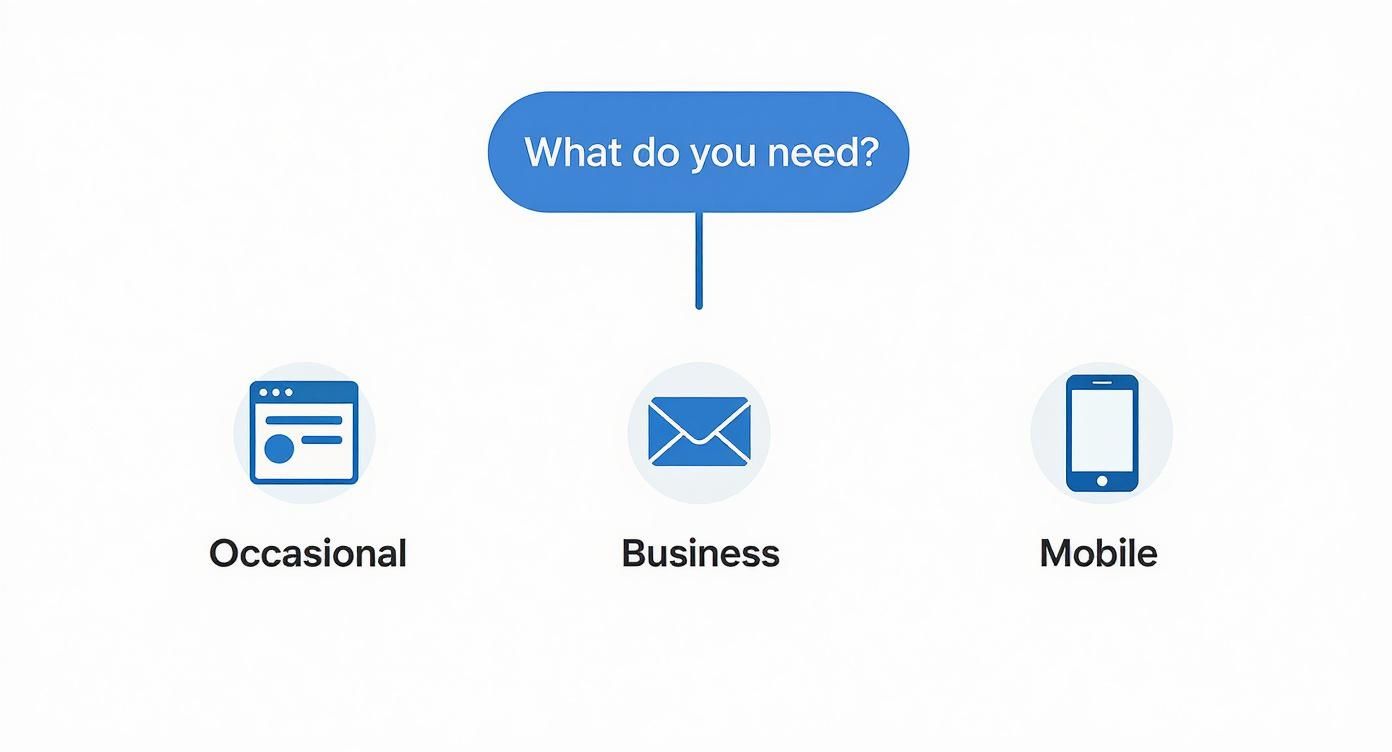
As you can see, thinking about how you'll use the service—occasionally, for business, or mainly on your phone—is the best first step to narrowing things down.
Assess Your Faxing Volume and Frequency
First things first, ask yourself: "How often will I really send a fax?" Your answer is the single biggest clue to finding the right plan. There's no sense in paying for a hefty monthly subscription if you only fax a document once in a blue moon.
- Occasional Users: If you're sending a signed form once or twice a year, a pay-per-use service is your best friend. These let you send a fax for a small, one-time fee with zero monthly commitment. It’s the most economical route for sporadic faxing.
- Regular Senders: For small businesses or professionals sending several faxes a month, a basic monthly subscription makes more sense. These plans typically give you a set number of pages (say, 150 pages/month) for a flat fee, which is far cheaper than paying per fax.
- High-Volume Organizations: A busy clinic, law firm, or larger company handling hundreds of pages needs a business or enterprise plan. These come with high page limits, accounts for multiple users, and advanced tools for managing everything.
Prioritize Security and Compliance
When you’re faxing sensitive information, security isn't just a feature—it's everything. This is especially true in fields like healthcare, finance, and law, where protecting data is a legal requirement.
Think about it: a traditional fax machine leaves sensitive documents sitting out in the open for anyone to see. The right online fax service, on the other hand, can offer vastly superior protection. Look for providers that are explicitly HIPAA compliant for medical records and use strong encryption (like SSL/TLS during transfer and AES-256 for storage) to keep your data under lock and key.
Choosing a service with strong security isn't just about ticking a box; it's a critical safeguard. Your confidential documents land directly in a secure inbox, completely bypassing the risk of being picked up by the wrong person at a shared office fax machine.
The global fax services market was valued at USD 3.31 billion in 2024 and continues to grow precisely because of its role in secure communication for regulated industries. Sectors like healthcare rely heavily on HIPAA-compliant digital faxing, which has helped make North America a dominant market. This tells you just how important it is to pick a service that meets these high security benchmarks. You can find more details on these trends in this detailed industry report.
Evaluate Usability and Essential Features
At the end of the day, the best service is one you don't have to fight with. A clunky, confusing interface can turn a simple two-minute task into a twenty-minute ordeal. Most reputable companies offer a free trial, which is the perfect way to take the platform for a test drive before you sign up.
As you poke around during your trial, keep an eye out for these must-have features.
A good online fax service should offer a blend of features that cater to different needs, from one-off sends to full business integration. The table below breaks down what you can typically expect from different plan levels.
Comparing Online Fax Service Features
| Feature | Pay-Per-Use Service | Basic Monthly Plan | Business Plan |
|---|---|---|---|
| Pricing Model | One-time fee per fax | Flat monthly fee | Higher monthly fee with tiered pricing |
| Included Pages | None (pay per page) | A set number (e.g., 150-300 pages) | High volume (e.g., 1,000+ pages) |
| Dedicated Fax Number | Usually not included | Yes, local or toll-free | Yes, multiple numbers, toll-free, and vanity numbers |
| User Accounts | Single user only | Typically one user | Multiple users with admin controls |
| Mobile App Access | Limited or none | Yes, full-featured | Yes, with advanced features |
| Security | Basic encryption | Enhanced encryption (e.g., SSL/TLS) | HIPAA compliance, advanced encryption, detailed audit trails |
| International Faxing | Available, higher per-page rate | Often included with specific country rates | Preferred rates, broader country support |
| API/Integrations | Not available | Limited or none | Yes, for integration with EMR, CRM, and other software |
This comparison makes it clear that your choice really depends on the scale of your needs. For a quick, one-off task, pay-per-use is perfect. But as soon as faxing becomes a regular part of your workflow, a subscription plan offers far more value and functionality.
While you're testing, also check for these practical features:
- File Format Support: Can it handle the files you use most, like PDF, DOCX, and JPG?
- Mobile Access: Is there a clean, functional mobile app for sending documents when you're not at your desk?
- Confirmation Receipts: Does the service provide detailed confirmation pages that can serve as proof of transmission? This is non-negotiable.
- International Faxing: If you send faxes abroad, make sure the service supports it and that you understand the costs involved.
By thoughtfully weighing your volume, security needs, and the overall user experience, you can pick an online fax service that fits like a glove. For more practical advice on modernizing business communications, see what other experts on our team have to say, like in these articles by Eric Dubs.
Getting Your Documents Ready for a Perfect Send
Sending a fax without an actual fax machine is a game-changer, but a successful transmission isn't just about picking the right service. The real secret to making sure your documents arrive looking crisp and professional lies in how you prepare them beforehand. Think of it this way: skipping these prep steps is like trying to send a blurry, crumpled letter through the mail. It just won't make a good impression.
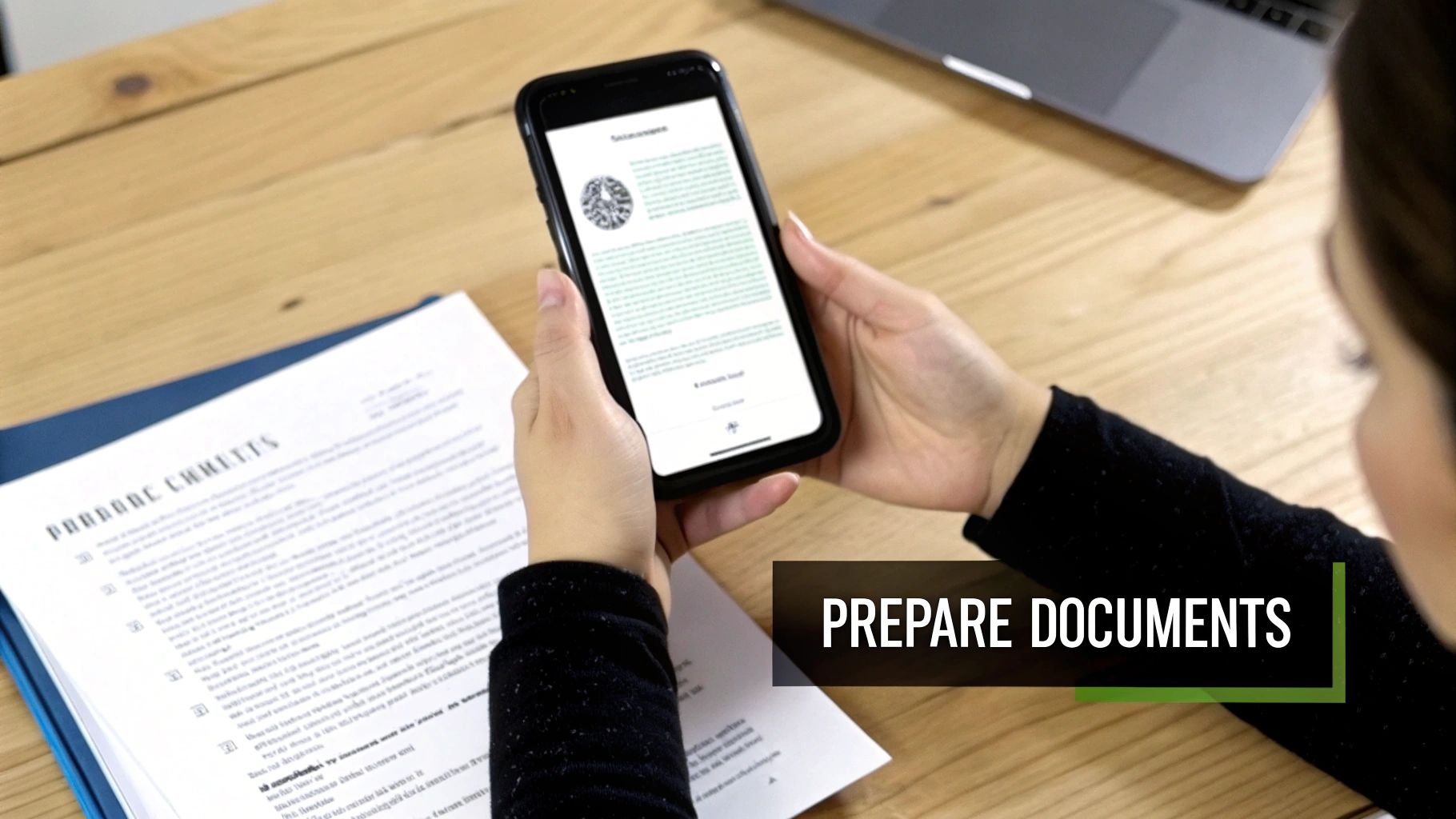
Taking just a couple of minutes to optimize your files and double-check the details can save you from the headache of a failed transmission, unreadable text, or worse—sending confidential info to the wrong number. Let’s walk through the essentials.
Pick the Right File Format
When you upload a document to an online fax service, it has to be converted into a language that old-school fax machines can understand. This is where file compatibility really matters. While most platforms are pretty flexible, one format consistently delivers the best results.
PDF is your best friend here. It's a universal standard that locks in all your formatting, fonts, and images. That means what you see on your computer screen is exactly what the recipient will get. Using other formats like a Word doc (DOCX) or a picture file (JPG) can sometimes cause weird layout shifts or text wrapping issues during the conversion process.
What if you have a physical piece of paper? Don't just snap a quick, shadowy photo with your phone. To get a clean digital copy:
- Use a Scanner App: Mobile apps like Adobe Scan or Microsoft Office Lens are fantastic. They’re designed to turn a phone picture into a high-contrast, black-and-white PDF that looks like it came from a proper scanner.
- Find Good Light: Lay your document on a flat, dark surface in a well-lit room. This simple trick eliminates the shadows that can make text hard to read.
- Watch the File Size: Most services have an upload limit, usually around 20-25 MB. If your file is too big, just use a free online tool to compress the PDF before you send it.
Don't Skip the Cover Sheet
A cover sheet is basically your fax's professional handshake. It instantly tells the recipient who sent the fax, who it's for, and what it's about. It's also your safety net, providing contact info in case something goes wrong.
Think of a cover sheet as the subject line and introduction of an email, all rolled into one. It provides crucial context and stops your important document from getting lost in a shuffle of papers on the other end.
Make sure your cover sheet includes these key details:
- To: Recipient's Name and Company
- From: Your Name and Company
- Date: Today's date
- Fax Number: The recipient’s fax number
- Pages: The total page count, including the cover sheet itself (e.g., "Page 1 of 5")
- Subject/RE: A quick, clear description of what's inside
The good news is that most online fax services generate a cover sheet for you automatically. You just fill in the blanks. Some even let you check out different templates and layouts, like this sample page, to see how it all looks.
Double-Check Security and Details
This is, without a doubt, the most important step, especially when you’re handling things like contracts, medical records, or financial data. Sending faxes digitally can be incredibly secure, but you have to be proactive.
First, make sure the service you’re using offers end-to-end encryption. This technology scrambles your data from the moment you hit "send" until it arrives at the destination, making it unreadable to anyone trying to intercept it.
Second—and I can't stress this enough—triple-check the recipient's fax number. A single wrong digit could send your private information to a complete stranger. Before you click send, confirm the number on a business card, in an email signature, or on their official website. If it’s really sensitive, a quick phone call to confirm is a small price to pay for peace of mind.
Solving Common Digital Faxing Problems
Even when you fax without a fax machine, things don’t always go perfectly. It's easy to get frustrated when a "failed transmission" error pops up or someone calls to say your document is unreadable. But don't worry—these issues are almost always simple to fix.
Think of yourself as a digital detective. Most problems come down to a handful of common culprits, like a shaky internet connection or a simple typo in the fax number. Let's dig into the most frequent headaches and get them sorted out.
Decoding the Failed Transmission Error
That "failed transmission" notification is probably the most common issue you'll run into. It’s the digital version of a busy signal, but the cause can be a bit more mysterious. Instead of just hitting resend and hoping for the best, a little quick investigation will save you a lot of time.
First things first: double-check the recipient's fax number. Seriously. A single wrong digit is the number one reason faxes fail. Find the number on an official website or in an email signature to be sure.
Next, think about what might be happening on the other end. Is their fax machine off, out of paper, or tied up with another incoming fax? Sometimes the best move is to simply wait 10-15 minutes and try again.
Also, take a look at your file size. Many services cap uploads at around 20 MB. If you have a massive, high-resolution scan, it might be timing out. Try using a free online tool to compress the PDF before sending it again. This one small step solves the problem more often than you'd think.
Why Your Fax Arrived Blurry or Unreadable
There's nothing worse than sending an important document, only to hear it arrived as a garbled, blurry mess. This problem almost never has to do with the fax service itself; it’s all about the quality of the file you uploaded.
Remember, fax technology is old-school. It transmits in black and white at a pretty low resolution (around 200 dpi). A color photograph or a document with a gray background just isn't going to look good on the other end.
To make sure your faxes arrive looking sharp:
- Start with a High-Quality Scan: Use a scanner app on your phone that creates crisp, black-and-white PDFs. Don't just snap a quick photo of a document in a dimly lit room.
- Use Simple Fonts: Stick to clean, standard fonts like Arial or Times New Roman. Anything too fancy or tiny can become illegible after transmission.
- Boost the Contrast: Before you send, make sure your document is just sharp black text on a clean white background. This is the key to readability.
The core principle is to prepare your document for a low-tech destination. By optimizing for black-and-white and high contrast, you ensure your digital file survives the journey back to an analog world without losing quality.
Addressing Unexpected Delays
You sent a fax an hour ago, but the recipient still hasn't seen it. What gives? Delays can happen for a few reasons, from network congestion with your provider to a problem with the receiving machine. Your best troubleshooting tool is the transmission report.
Check the report for the fax's status. If it says "Pending" or "In Progress," a little patience is usually all that's needed. But if it's been stuck for over 30 minutes, it might be time to cancel and resend. If it keeps happening, a quick message to your service provider's support team can tell you if there’s a wider network issue.
The move toward digital faxing is a huge part of how modern businesses operate, and it's not slowing down. While the global market for fax machines was valued at around USD 569.54 million in 2024, its projected growth is actually driven by multifunction printers and online fax services, not standalone machines. Industries like healthcare still rely heavily on faxing but are rapidly switching to cloud-based platforms. You can read more about the evolution of the fax market to get a better sense of these industry shifts.
Common Questions About Faxing in the Modern Age
Even after you've found a way to send a fax without a dusty old machine, some questions usually pop up. Moving from hardware to a digital service is a change, and it's smart to make sure you're handling your documents correctly. Let's tackle some of the most common questions I hear from people making the switch.
Are Faxes Sent Online Actually Legally Binding?
Yes, they are. For almost any situation you'll encounter, a fax sent from a reputable online service carries the same legal weight as one from a traditional machine. What matters in a legal context isn't the machine itself, but the proof that the document was successfully sent and received.
This is actually an area where online fax services have a serious edge. They automatically generate detailed confirmation reports for every single fax. These digital receipts are gold, typically including:
- The exact date and time of transmission.
- The total number of pages that went through.
- The recipient's fax number.
- A clear status confirming successful delivery.
Honestly, this digital paper trail is far more reliable and easier to archive than the flimsy thermal paper receipt you'd get from an old machine. For contracts and official notices, that level of verification is exactly what you need. That said, for super-sensitive legal filings, it never hurts to double-check the recipient's preferred delivery method first.
Can I Get Faxes Sent to Me Without a Fax Machine?
You sure can. Receiving faxes digitally is just as straightforward as sending them. When you sign up for an online fax service (even some free ones), you're given your own dedicated fax number. You can usually choose a new local or toll-free number, and some providers will even help you transfer an existing fax number you already use.
The process is seamless.
- Someone sends a document to your new fax number from their machine.
- The online fax service's servers catch the transmission.
- The service instantly converts that fax into a PDF.
- Finally, that PDF lands right in your email inbox or a secure online account.
It's a game-changer. Suddenly, you can check your faxes from your phone on your lunch break or from your laptop at home. You're completely free from a physical office, not to mention the costs of paper, ink, and toner.
How Secure Is Sending Sensitive Information This Way?
This is a big one, and the answer might surprise you: online faxing is often significantly more secure than using a traditional machine. Think about it—a fax sent to a typical office machine sits out in the open on a tray, where anyone can walk by, see it, or even pick it up by mistake.
Good online fax services completely remove that physical risk. They build their platforms around protecting your data both in transit and at rest.
When you're choosing a service, the single most important security feature to look for is end-to-end encryption. This scrambles your document the moment you send it and keeps it that way until it reaches the provider's servers, making it gibberish to anyone trying to intercept it.
If you're handling things like medical records or financial documents, you should also look for services that are compliant with regulations like HIPAA. This ensures your sensitive files are delivered directly to your password-protected inbox, providing a level of privacy that a shared office machine could never hope to match.
What if I Only Need to Send a Single Fax?
No problem at all. You definitely don't need to sign up for a monthly subscription if you just have a one-off document to send. The digital faxing world is built to be flexible.
Plenty of online fax services and mobile apps offer a pay-per-fax option. You just pay a small, one-time fee to send your document and you're done—no strings attached. Some platforms also have a limited free trial, which is perfect for sending a quick, non-urgent fax.
And if you'd rather handle it in person, you can always head to a public faxing location. Places like FedEx Office or The UPS Store have fax machines available for public use. You just pay a small fee per page. It's a simple, old-school solution for those who only need to fax once in a blue moon.
Ready to send a fax right now without signing up for an account? With SendItFax, you can send your document securely from your browser in minutes. For quick, reliable, and straightforward faxing, give our service a try.

